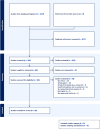A systematic review and meta-analysis of the first decade of compositional data analyses of 24-hour movement behaviours, health, and well-being in school-aged children
- PMID: 40217545
- PMCID: PMC11948812
- DOI: 10.1186/s44167-025-00076-w
A systematic review and meta-analysis of the first decade of compositional data analyses of 24-hour movement behaviours, health, and well-being in school-aged children
Abstract
Introduction: Movement behaviours (e.g., sleep, sedentary behaviour, light physical activity [LPA], moderate to vigorous physical activity [MVPA]) are associated with numerous health and well-being outcomes. Compositional data analyses (CoDA) accounts for the interdependent nature of movement behaviours. This systematic review and meta-analysis provides a timely synthesis of the first decade of CoDA research examining the association between movement behaviours, health, and well-being in school-aged children.
Methods: Databases were systematically searched for peer-reviewed studies examining CoDA associations between movement behaviours and health or well-being in school-aged children (5.0-17.9 years). All health and well-being outcomes were eligible for inclusion, as were all methods of reporting CoDA results. Where possible meta-analyses were conducted.
Results: Twenty-six studies were included in the review. Sample sizes ranged from 88 - 5,828 (median = 387) participants and the mean ages ranged from 8 to 16 years. Regression parameters (kstudies=16) were the most common method of reporting results, followed by substitution effects (kstudies=12), optimal compositions (kstudies=3), and movement behaviour clusters (kstudies =1). Weighted compositional means of movement behaviours were calculated (e.g., 49.8 min/day of MVPA). For regression analyses, results were generally null, though some favourable trends were observed for MVPA and unfavourable trends for LPA and sedentary behaviour within individual health and well-being outcomes categories. Meta-analyses of substitutions supported the benefits of MVPA, with the risks of reducing MVPA for other movement behaviours being double the magnitude compared to the benefits of adding MVPA.
Discussion: The most consistent conclusions within this review align with previous reviews that support the benefits of MVPA. Further, some evidence supported 24-hour movement behaviour guideline recommendations of increasing sleep and decreasing sedentary behaviour. This review also quantified not only the need to promote MVPA, but perhaps more importantly the urgency needed to preserve the limited MVPA children currently accumulate. Findings reinforce the "more/less is better" messages for movement behaviours, but do not allow us to recommend more specific balances of movement behaviours. As CoDA of movement behaviours progresses and accumulates further research, the methods and discussion points within the current review can aide future meta-analyses aimed at advancing the precision health guidance needed for optimizing children's health and well-being.
Keywords: Compositional data analysis; Movement behaviours; Physical activity; Sedentary behaviour; Sleep.
© 2025. The Author(s).
Conflict of interest statement
Declarations. Ethics approval and consent to participate: Not applicable. Consent for publication: Not applicable. Competing interests: The authors declare no competing interests.
Figures



Similar articles
-
The association between reallocations of time and health using compositional data analysis: a systematic scoping review with an interactive data exploration interface.Int J Behav Nutr Phys Act. 2023 Oct 19;20(1):127. doi: 10.1186/s12966-023-01526-x. Int J Behav Nutr Phys Act. 2023. PMID: 37858243 Free PMC article.
-
Cross-sectional associations between sleep duration, sedentary time, physical activity, and adiposity indicators among Canadian preschool-aged children using compositional analyses.BMC Public Health. 2017 Nov 20;17(Suppl 5):848. doi: 10.1186/s12889-017-4852-0. BMC Public Health. 2017. PMID: 29219077 Free PMC article.
-
The association between 24-h movement behaviours and adiposity among Australian preschoolers: a compositional data analysis.BMC Public Health. 2025 Jan 29;25(1):368. doi: 10.1186/s12889-024-21217-x. BMC Public Health. 2025. PMID: 39881264 Free PMC article.
-
Fitness, fatness and the reallocation of time between children's daily movement behaviours: an analysis of compositional data.Int J Behav Nutr Phys Act. 2017 May 10;14(1):64. doi: 10.1186/s12966-017-0521-z. Int J Behav Nutr Phys Act. 2017. PMID: 28486972 Free PMC article.
-
Health outcomes associated with reallocations of time between sleep, sedentary behaviour, and physical activity: a systematic scoping review of isotemporal substitution studies.Int J Behav Nutr Phys Act. 2018 Jul 13;15(1):69. doi: 10.1186/s12966-018-0691-3. Int J Behav Nutr Phys Act. 2018. PMID: 30001713 Free PMC article.
Cited by
-
Cross-sectional and longitudinal associations between sleep, sedentary behaviour and physical activity with adiposity and cardio-respiratory fitness in school-aged children: a compositional data analysis.J Act Sedentary Sleep Behav. 2025 Jul 11;4(1):11. doi: 10.1186/s44167-025-00082-y. J Act Sedentary Sleep Behav. 2025. PMID: 40646662 Free PMC article.
References
-
- Duncan MJ, Patte KA, Leatherdale ST. Mental health associations with academic performance and education behaviors in Canadian secondary school students. Can J School Psychol. 2021;36(4):335–57.
LinkOut - more resources
Full Text Sources
Research Materials
Miscellaneous
